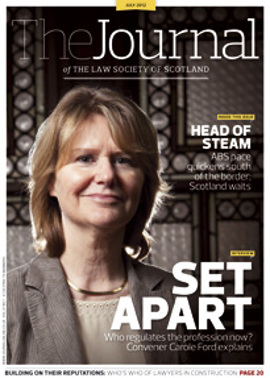Take another look
The Supreme Court’s recent judgment in the case of NJDB v JEG [2012] UKSC 21 (23 May 2012) has attracted much comment, primarily because it seems remarkable that a case such as this came to the attention of the Supreme Court at all. The proof ran to 52 days of evidence, taking over a year to complete. The Supreme Court took the opportunity to comment on the manner in which child law cases are dealt with in Scotland. A few points of good practice can be distilled.
There is nothing striking about this case in terms of black letter law. Arguably there is nothing particularly complex about the factual issues in dispute. The case was about whether it was in the best interests of a child to have contact with his father. Proceedings were initially raised in 2003, when the child was three years old. By the time of the Supreme Court judgment the child was 12. While the litigation was in its infancy, a joint minute was entered into, recording agreed arrangements. A dispute arose about the practicalities of how contact should be exercised. Procedure became protracted. A curator was appointed to the child. The curator entered process. The pleadings were extensive. Amid all the pleading and procedure, no contact was being exercised.
It can be easy to lose sight of the bigger picture in discharging one’s professional duty to represent clients, particularly in child law cases, where incidents seem significant in magnitude and emotional intensity. Sensitively inviting clients to take a step back and remember what such cases are really about, can sometimes assist clients in relegating some concerns to the status of being less important than the aim of enabling their child to enjoy a less stressful childhood.
One wonders whether an alternative method of resolution might have been appropriate. Had parties been directed to mediation at an early stage, the mechanics of how contact should operate might have been capable of swift agreement. It is possible for a sheriff to refer parties to mediation in terms of rule 33.22 of the Ordinary Cause Rules 1993. Practitioners may wish to consider making reference to this rule in the conduct of child welfare hearings.
Keeping it brief
The system of written pleadings was subject of comment. The Lord President commented: “it might be that the liberty which professional advisers enjoyed in this field should be curtailed”. Does this signal the end of the record as we know it?
Until such time as the Ordinary Cause Rules are amended to the contrary, the current system of pleading remains. Common sense should prevail – is it really necessary to plead detail about each and every incident highlighting the fact that parents disagree about the mechanics of handovers?
Lord Reed endorsed the Lord President’s remarks in NJDB v JEB by emphasising “the duty of counsel and other professional advisers to concentrate on the issue, namely the welfare of the child, rather than exploring every byway in the relationship between the parents”. Pleading evidence is unnecessary, subject to the requirement of giving fair notice to your opponent of what your client’s position will be at proof. This has always been the case, though child law practitioners do seem to avail themselves of a less stringent and more verbose way of pleading their client’s case. A focus on the fundamental issue may assist in curtailing pleadings and therefore the scope of any proof.
The pre-proof hearing offers a useful case management tool. If practitioners can focus on having a frank, open dialogue with the bench and with their opposite number at the hearing about witness evidence and the scope of the evidence to be led, it will be easier for agents and indeed the sheriff hearing the proof to make decisions during the conduct of the proof itself about what evidence is necessary, relevant and appropriate.
The Supreme Court decision also offers food for thought to those of us appointed to act as reporters and curators. It seems appropriate and potentially helpful for practitioners to invite the sheriff to clarify the envisaged role of the reporter or curator in individual cases. Specific direction to restrict the scope of a report to the views of a child could potentially avoid an exacerbation of tensions between parents by avoiding lengthy narratives about “the byways”.
In this issue
- On your marks
- Many's a crowd
- Family migration
- Assessing internet sex offenders
- Division and sale - disposal inter se
- Reading for pleasure
- Opinion column: Elaine Motion
- Council profile
- Book reviews
- President's column
- Into the front line
- A few more bricks
- Eye on the profession
- One eye over the border
- Who's who in construction
- Speed up child cases
- Take another look
- Relief on the review front
- Waste not
- Scottish Solicitors' Discipline Tribunal
- Financial services regulation: the race to reform
- Leases: where next?
- A wake-up call?
- Law reform roundup
- From the Brussels office
- Update: Registered Paralegal Scheme
- Business checklist
- Ask the experts
- Ask Ash






